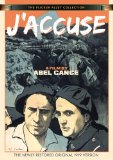| Reviews & Columns |
|
Reviews DVD TV on DVD Blu-ray 4K UHD International DVDs In Theaters Reviews by Studio Video Games Features Collector Series DVDs Easter Egg Database Interviews DVD Talk Radio Feature Articles Columns Anime Talk DVD Savant Horror DVDs The M.O.D. Squad Art House HD Talk Silent DVD
|
DVD Talk Forum |
|
|
| Resources |
|
DVD Price Search Customer Service #'s RCE Info Links |
|
Columns
|
|
|
J'Accuse
Flicker Alley // R // September 16, 2008
List Price: $39.95 [Buy now and save at Amazon]
The Film:
One of the first great anti-war films was Abel Gance's J'Accuse. Filmed near the end of WW I and released in 1919, six years before King Vidor's The Big Parade, the movie is a powerful indictment about the horrors of war as well as a ground breaking and technically innovative piece. Flicker Alley, in association with Lobster Films has now released the restored version of this important film on DVD. The most complete version of the film since its original screening in 1919, this two-disc set presents the wonderfully restored film as well as some very nice extras.
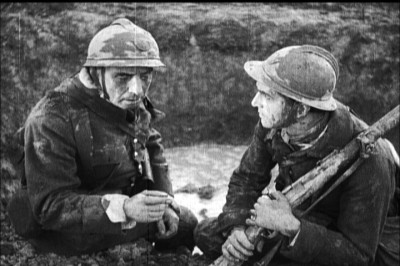
Edith (Maryse Dauvray) is married to the gruff and stern hunter François (Séverin-Mars). She doesn't love him and was forced into marriage by her father who respects the rugged outdoorsman. Edith is really in love with a poet, Jean Diaz (Romould Joube), and the two try to sneak away for a quiet moment together whenever they can.
Things are interrupted when war breaks out. The citizens are elated that they'll finally get a chance to bet the Huns, and François enlists immediately. Jean, a member of the reserves, doesn't have to report for 40 days however.
On a quick stop over after basic training, François discovers a love letter to his wife from Jean. Enraged, his first thought is to kill the young man, but his father-in-law talks him out of it. After all if he does that, he won't be able to fight. Instead, he sends his wife off to live with his parents in the mountains.
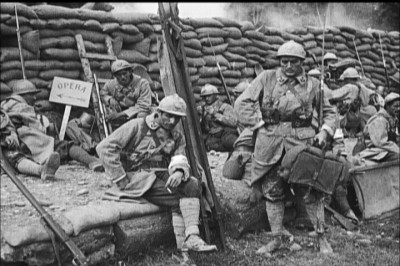
Things don't go as planned, and Edith is captured by Germans on her way to her in-laws, taken prisoner and brutally raped, repeatedly. When Jean hears of this, he moves up his call-up date and goes to the front to rescue the woman he loves. There he is stationed with François, and while the two initially hate each other, they soon realize that they are fighting for the same thing. While the two men are bound together by love for the same woman and the horrors of war, things soon take a more tragic turn that will leave no one unscathed.
This is a powerful film that leaves quite an impression. Gance told the French government that the film could be used as a recruiting tool, so they allowed him to film at the front (he captured part of the Battle of St. Mihiel) and the footage was used in the movie. He was also able to use soldiers on leave as extras in the climactic scene where the dead come back to life. Most of the men used in this scene were in the army and were tragically killed weeks later. Still, they had seen battle in the trenches of France and you can tell by the looks on their faces that they weren't acting so much as reacting to what they had experienced.
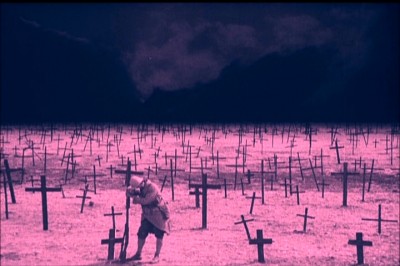
In addition to using real soldiers, Gance employed many innovative techniques to get his point across. He would cross cut between two images to give the aspects of one to another. A good example of this is when François comes home after hunting with a dead dear. Gance quickly cuts between the man's face and that of his snarling dog to show how vicious François can be.
Another impressive scene, cut not quite as quickly, shows Jean reading his poem "Ode to the Sun" to his mother one evening while across town his love is being forced to have sex by her husband. The juxtaposition between the terrified woman and the happy poet is striking and effectual.
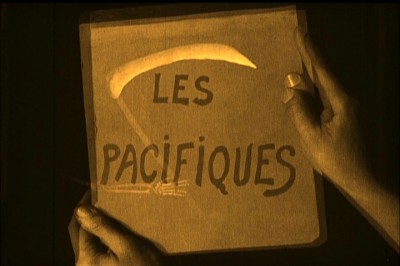
There's also a lot of superimposition used through the film, to great effect. Jean is writing a book of poems, "La Pacifiques", but when war is declared the skeletal hand and scythe of death appear over the cover of the book. There are also several scenes of skeletons dancing in a circle superimposed over the city to foreshadow the death that will come.
Gance didn't need to use editing tricks to make powerful statements however. One of the scenes that will stay with viewers is a young child, still in diapers, running up to his playmates and declaring "It's war!"
Another simple yet memorable sequence shows the preparations across the town as men are getting ready to go off to war. Instead of using wide shots however, Gance only shows the hands of the men and their loved ones: A small child putting his petit hands in those of his father, a man lighting a candle and putting his hands together in prayer, and a husband and wife clutching each other as they are packing a satchel. These tender and brief moments succinctly illustrate how the families were feeling without becoming melodramatic or slowing the pace down.
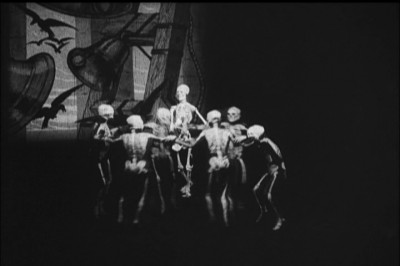
Of course the most amazing scene in the film is the climax, where a crazed man imagines all of the dead soldiers from the war getting up and going back to their home towns to see if their sacrifice had been worth while. It's an impressive scene and really drums home the director's point.
The DVD:
Audio:
The film includes a new score composed and conducted by Robert Israel and performed by the Robert Israel Orchestra. I really enjoy full orchestra scores, and this one was very good. Several different styles were used to get across the feelings portrayed on the screen and it worked very well. I especially liked the march that was played during the scene where François was informed that Edith was captured by the Germans. Being a recent score there were no audio defects worth noting.
Video:
The restoration of this film was done by the Nederlands Filmmuseum with the cooperation of Lobster Films, Flicker Alley, and Turner Entertainment. The core of this version comes from the only existing color tinted version of the film still in existence (held by the Nederlands Filmmuseum) and a 50 year old restoration done by the Cinematheque Francais. These, along with several other edits of the film (including one reel of original camera negative) were used to create the final 3525 meter film, the longest version since the original opening in 1919 and nearly 500 m longer that the French restoration.
The image (tinted and toned) is superb. It really looks wonderful. The level of detail is excellent and the contrast is very good. Viewers can tell when the film switches between various master copies, as some of the prints weren't as tight and crisp as others, but there wasn't any section of the film that looked bad. This is a truly remarkable restoration that looks wonderful on DVD.
Extras:
There are a couple of great extras on the second disc; two short films shot in France during WWI. The first is "Paris During the War" (1915) a humorous look at people living in Paris during the War to End All Wars. It's amusing and worth watching for the nearly empty streets. The second is "Fighting the War" (1916) which adventurer Donald Thompson films scenes in the trenches, artillery firing, and even a dog fight from the air. This film is an amazing record.
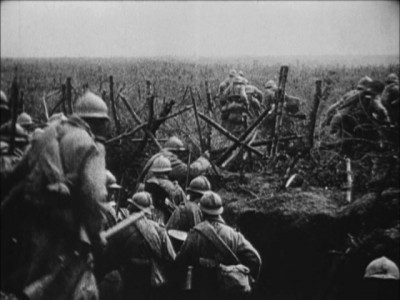
There's also an informative 20 page booklet with an essay about J'Accuse by Kevin Brownlow. He reminisces about his first viewing of the film as well has interviewing Able Gance. There are also shorter pieces about the restoration and the influence Gance had on novelist Virginia Woolf.
Final Thoughts:
This is a truly great film. A true piece of film history, it is one of the first, if not the first anti-war movies. The fact that it was filmed during WWI and has such a large scope is truly impressive. Not only is it an early pacifist film, but it's also an incredible movie in and of itself. Gance crafted a beautiful gem of a film and it's still powerful nearly 90 years later. Flicker Alley and Lobster Films have put together a wonderful package with an amazing looking transfer and some great extras. This set come highly recommended.
|
| Popular Reviews |
| Sponsored Links |
|
|
| Sponsored Links |
|
|
| Release List | Reviews | Shop | Newsletter | Forum | DVD Giveaways | Blu-Ray | Advertise |
|
Copyright 2024 DVDTalk.com All Rights Reserved. Legal Info, Privacy Policy, Terms of Use,
Manage Preferences,
Your Privacy Choices | |||||||









